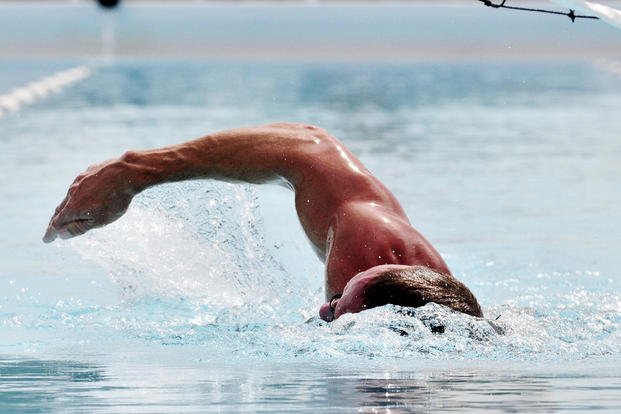During military swimming evaluations that involve the breaststroke or side stroke (often referred to as combat side stroke, or CSS), you can execute an underwater pullout from the wall known as the “breaststroke pullout. Over time, I have trained recruits for the Navy Physical Screening Test (PST) by incorporating this technique but have recently shifted […]


During military swimming evaluations that involve the breaststroke or side stroke (often referred to as combat side stroke, or CSS), you can execute an underwater pullout from the wall known as the “breaststroke pullout. Over time, I have trained recruits for the Navy Physical Screening Test (PST) by incorporating this technique but have recently shifted to encouraging its removal, especially among non-swimmer athletes.
The kick-off from the wall followed by a glide offers a distance allowance in the swim that does not require any actual swimming, just a strong kick and a streamlined position. By maximizing your push off the wall, you can effectively turn a 500-yard swim into a 300-yard swim by gliding 10 yards off the wall after each turn, making your kickoff a critical factor; your subsequent actions are less significant depending on your skill level.
This video link illustrates the difference when skipping the pullout.
Below are some advantages of omitting the pullout during this 500-yard swim assessment:
1. You Receive an Extra Breath Per Lane
In a 25-yard pool, you can kick off the wall 20 times during a 500-yard swim evaluation. By eliminating the underwater pullout, you earn an additional 20 breaths. This can significantly impact your ability to sustain pace throughout the swim or result in fatigue that hinders meeting your pacing objectives for the test.
2. Most Individuals Swim Faster Without It
If you’re inexperienced in swimming, an awkward transition occurs when moving from the pullout to the swim stroke (breaststroke or CSS). Stalling in the water midway through the pool impairs the speed gained from the initial wall kick. Regaining that momentum in the pool adds time to your overall swim. While it might only seem to be a few seconds, when multiplied across 20 uses, you could lose up to a minute. Many people have shaved 40-45 seconds off their time by skipping the pullout.
3. It Demands a Higher Level of Conditioning
You could potentially reduce your swim training duration by several weeks by bypassing the pullout. To execute the pullout consistently during a 500-yard swim, many non-swimming athletes may not possess the requisite conditioning. Although they may begin with the pullout, they often find the extra underwater breath hold from this move overwhelming and instinctively opt to skip it.
The issue arises when they attempt it with an elevated heart rate and breathing pace, facing another 200-300 yards to complete the swim, which depletes their energy unnecessarily. There’s nothing wrong with completely bypassing the pullout, as it demands more pool time than many recruits can allocate while preparing for various other events (like pool skills, running, rucking, weightlifting, and calisthenics).
4. You Can Enhance Your Performance in the Other Events of the Test
If incorporating the pullout forces you into an anaerobic state early in your swim, you might deplete the glucose and glycogen essential for succeeding in subsequent events like push-ups, sit-ups, pull-ups, and a 1.5-mile timed run. The remaining portions of the test could be adversely affected if you’re worn out after the swim. Adding extra breaths and trimming your swim time could improve your results on the five-event PST.
Keep an eye out for these warning signs as you decide whether to utilize the pullout:
- Your swim times are failing to meet the standards for obtaining a contract.
- You come to a standstill in the pool after the pullout as you shift into the stroke.
- You feel fatigued and naturally skip the pullout a few hundred yards into the swimming evaluation.
- You need to glide longer off the wall before initiating your stroke. It may be advisable to refine your streamlined body posture and kicking strength instead of adding a pullout.
If you’re struggling with the breaststroke pullout from the wall, you have options. You can choose to eliminate it and focus on delivering a strong kick off the wall, achieving a long glide, perfecting your initial arm pull, and mastering the turn-and-breathe sequence of the CSS. Alternatively, you can dedicate more time to practicing the pullout, improve your fitness level to manage it every time you kick off the wall, and keep your pace throughout the entire 500-yard swim. Check out additional breaststroke pullout videos.
Want to Discover More About Military Life?
Whether you’re contemplating a military career, seeking fitness or basic training advice, or wanting to stay informed on military life and benefits, Military.com has what you need. Subscribe to Military.com to receive updates, news, and resources directly in your inbox.














